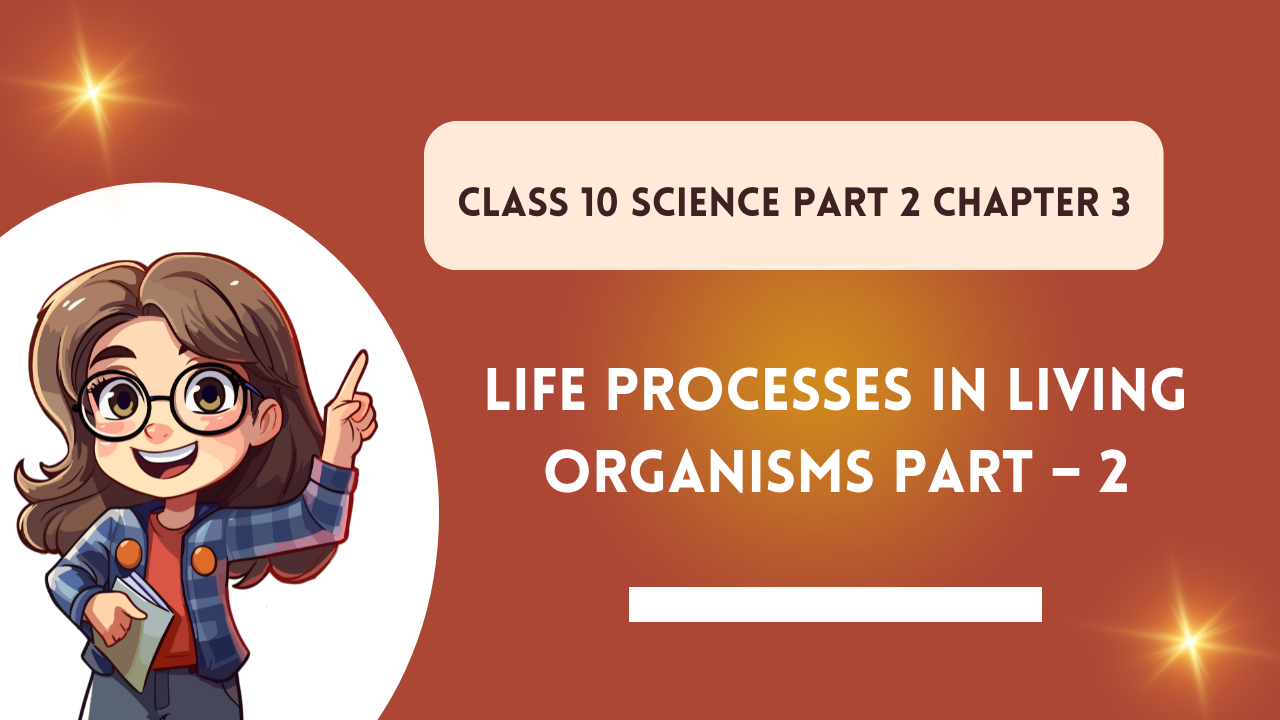Balbharti Maharashtra State Board Class 10 Science Solutions Part 2 Chapter 3 Life Processes in Living Organisms Part – 2 Notes, Textbook Exercise Important Questions and Answers.
Std 10 Science Part 2 Chapter 3 Life Processes in Living Organisms Part – 2 Question Answer Maharashtra Board
Class 10 Science Part 2 Chapter 3 Life Processes in Living Organisms Part – 2 Question Answer Maharashtra Board
Question 1.
Complete the following chart.
| Asexual reproduction | Sexual reproduction |
| 1. Reproduction that occurs with the help of somatic cells is called asexual reproduction. |
1. __________________________________________
____________________________________________ |
|
2. __________________________________________
____________________________________________ |
2. Male and female parent are necessary for sexual reproduction. |
| 3. This reproduction occurs with the help of mitosis only. |
3. __________________________________________
____________________________________________ |
|
4. __________________________________________
____________________________________________ |
4. New individual formed by this method is genetically different from parents. |
| 5. Asexual reproduction occurs in different individuals by various methods like binary fission, multiple fission, budding, fragmentation, regeneration, vegetative propagation, spore production, etc. |
5. __________________________________________
_____________________________________________ _____________________________________________ _____________________________________________ |
Answer:
| Asexual reproduction | Sexual reproduction |
| 1. Reproduction that occurs with the help of somatic cells is called asexual reproduction. | 1. Reproduction that occurs due to fertilization of gametes is called sexual reproduction. |
| 2. For asexual reproduction only one parent is necessary. | 2. Male and female parents are necessary for sexual reproduction. |
| 3. This reproduction occurs with the help of mitosis only. | 3. This reproduction occurs with the help of both mitosis and meiosis. |
| 4. New individual formed by this method is genetically identical with parents. | 4. New individual formed by this method is genetically different from parents. |
| 5. Asexual reproduction occurs in different individuals by various methods like binary fission, multiple fission, budding, fragmentation, regeneration, vegetative propagation, spore production, etc. | 5. Sexual reproduction occurs in two steps: First formation of haploid gametes by meiosis and then fertilization of these haploid gametes to form diploid zygote. There are no subtypes in the sexual reproduction. |

Question 2.
Fill in the blanks.
a. In humans, sperm production occurs in the organ …………
(a) prostate gland
(b) testis
(c) ovaries
(d) Cowper’s gland
Answer:
(b) testis
b. In humans, …………. chromosome is responsible for maleness.
(a) X
(b) Y
(c) Z
(d) O
Answer:
(b) Y
c. In male and female reproductive system of human, …………. gland is same.
Answer:
There is no similar gland in male and female reproductive system. There may be some homologies but there is no similarity.
d. Implantation of embryo occurs in …………
(a) ovaries
(b) fallopian duct
(c) uterus
(d) vagina
Answer:
(c) uterus
e. …………type of reproduction occurs without fusion of gametes.
(a) Asexual
(b) sexual
(c) Fertilization
(d) Gamete formation
Answer:
(a) Asexual
f. Body breaks up into several fragments and each fragment begins to live as a new individual.
This is ………. type of reproduction.
(a) regeneration
(b) fragmentation
(c) binary fission
(d) budding
Answer:
(b) fragmentation
g. Pollen grains are formed by division in locules of anthers.
(a) meiosis
(b) mitosis
(c) amitosis
(d) binary
Answer:
(a) meiosis
Question 3.
Complete the paragraph with the help of words given in the bracket:
(Luteinizing hormone, endometrium of uterus, follicle stimulating hormone, estrogen, progesterone, corpus luteum)
Growth of follicles present in the ovary occurs under the effect of ………….. This follicle secretes estrogen. Ovarian follicle along with oocyte grows/regenerates under the effect of estrogen. Under the effect of ………….., fully grown up follicle bursts, ovulation occurs and …………….. is formed from remaining part of follicle. It secretes ……………. and ………. Under the effect of these hormones, glands of ……….. are activated and it becomes ready for implantation.
Answer:
Growth of follicles present in the ovary occurs under the effect of f
ollicle stimulating hormone
. This follicle secretes estrogen. Ovarian follicle along with oocyte grows/regenerates under the effect of estrogen. Under the effect of
Luteinizing hormone
, fully grown up follicle bursts, ovulation occurs and
corpus luteum
is formed from remaining part of follicle. It secretes
estrogen
and
progesterone
. Under the effect of these hormones, glands of
endometrium of uterus
are activated and it becomes ready for implantation.

Question 4.
Answer the following questions short.
a. Explain with examples types of asexual reproduction in unicellular organism.
Answer:
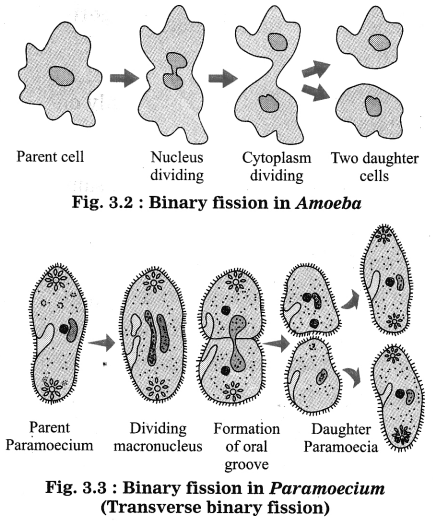
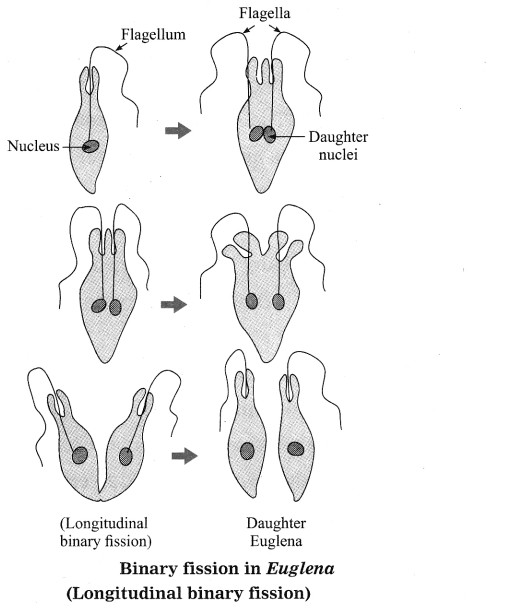
There are different methods of asexual reproduction in different unicellular animals.
(1) Binary fission: The process in which the parent cell divides to form two similar daughter cells
is binary fission. It takes place either by mitosis or amitosis. When there are favourable conditions and abundant food supply then the organisms undergo binary fission. Prokaryotes, Protists and eukaryotic 5 cell-organelle like mitochondria and chloroplasts perform binary fission.
Based on axis of fission there are three subtypes of binary fission.
(a) Simple binary fission: The plane of division is not definite, it can be in any direction due to lack of specific shape as in Amoeba.
(b) Transverse binary fission: The plane of J division is transverse, as in Paramoecium.
(c) Longitudinal binary fission: The plane of division is in length-wise direction as in Euglena.
(2) Multiple fission:
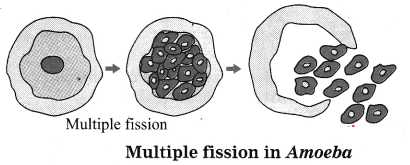
During unfavourable conditions when there is lack of food, multiple fission is shown by amoeba. Amoeba forms protective covering and becomes encysted. Inside the cyst, amoeba undergoes repeated nuclear division. This is followed by cytoplasmic divisions. Many amoebulae are formed which remain dormant inside the cyst. When favourable conditions reappear, they come out by breaking the cyst.
(3) Budding in yeast:

Yeast is unicellular fungus that performs budding. The parent cell produces two daughter nuclei by mitotic division. This results in a small bulgingbud on the surface of parent cell. One daughter nucleus enters the bud. It then grows and upon becoming big it separates from the parent cell to have independent life as new yeast cell.
b. Explain the concept of IVF.
Answer:
(1) IVF means In Vitro Fertilization (IVF)
(2) This is the technique in the modern medical field where childless couples can be blessed by their own child.
(3) IVF technique is used for childless couples who are faced with problems such as less sperm count, obstacles in oviduct, etc.
(4) The IVF technique is done by removing the oocyte from the mother and artificially fertilizing by the sperms collected from father. This fertilization is done in a test-tube. Thus it is also called test tube baby. The embryo formed is implanted in uterus of real mother or a surrogate mother at appropriate time.
c. Which precautions will you follow to maintain the reproductive health?
Answer:
About reproductive health one should have scientific and authentic information. The cleanliness of body is very essential but keeping the mind clean is also important to maintain good reproductive health. One should be careful about sexual relationships. These things should not be experimented in young age. Mistakes committed like these can change the sexual health forever. The cleanliness and hygiene during menstruation, the cleanliness of genitals and other private parts are the aspects of personal hygiene. When living in a society, one should always be away from cross-infections of venereal type.
d. What is menstrual cycle? Describe it in brief.
Answer:
- Menstrual cycle is the events of cyclic changes that takes place with the interval of 28 to 30 days in mature woman.
- Hormones from pituitary, FSH (Follicle Stimulating Hormone) and LH (Luteinizing Hormone) and hormones from ovary, estrogen and progesterone control the menstrual cycle.
- Due to influence of FSH, the ovarian follicle grows along with the oocyte that is present in it.
- This growing follicle produces estrogen.
- Under the influence of estrogen, the uterine inner layer called endometrium grows or regenerates. In the meantime the development of follicle is completed.
- LH from pituitary stimulates the bursting of ovarian follicle and releases the mature oocyte out of the follicle and the ovarian wall. This process is called ovulation.
- The empty ovarian follicle after the ovulation becomes corpus luteum. Corpus luteum produces hormone progesterone.
- Under the influence of progesterone, the glands from uterine endometrium start secreting. The oocyte if fertilized is implanted over this endometrium.
- If oocyte is not fertilized, the corpus luteum becomes a degenerate body called corpus albicans. The corpus albicans cannot secrete estrogen and progesterone.
- Due to lack of these hormones, the endometrial layer of the uterus collapses. The tissue debris, along with unfertilized egg is given out through the vagina as menstrual flow. This results in bleeding for about 5 days.
- If woman is not pregnant, then this menstrual cycle keeps on repeating with regularity.
Question 5.
In case of sexual reproduction, newborn show similarities about characters. Explain this statement with suitable examples.
Answer:
(1) Sexual reproduction occurs due to two different gametes. One male gamete is from father while the other female gamete is from mother.
(2) Both the gametes are produced by meiosis.
(3) When the gametes unite it is called process of fertilization which produces diploid zygote.
(4) Due to the chromosomes of parents, their DNA pass to the next generation through such fertilization. Therefore, the characters of newborn show similarities with parents.
Question 6.
Sketch the labelled diagrams.
a. Human male reproductive system.
Answer:

b. Human female reproductive system.
Answer:
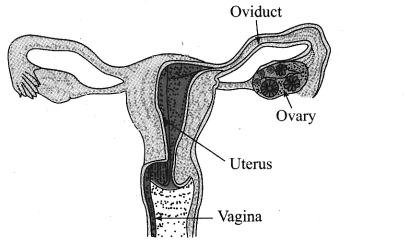
c. Flower with its reproductive organs.
Answer:
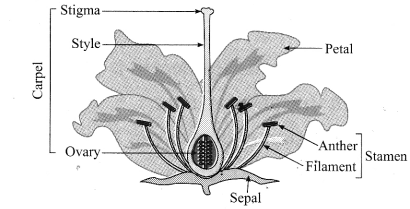
d. Menstrual cycle.
Answer:
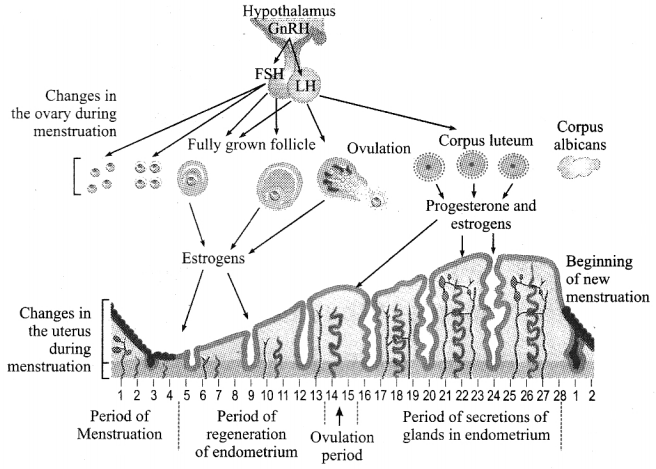

Question 7.
Give the names.
a. Hormones related with male reproductive system.
Answer:
Follicle stimulating hormone and ICSH or Luteinizing hormone secreted by pituitary gland, testosterone secreted by testis.
b. Hormones secreted by ovary of female reproductive system.
Answer:
Estrogen and progesterone.
c. Types of twins.
Answer:
Monozygotic twins, Siamese twins and Dizygotic twins.
d. Any two sexual diseases.
Answer:
Gonorrhea and Syphilis.
e. Methods of family planning.
Answer:
Copper T, condoms, oral contraceptive pills.
Question 8.
Gender of child is determined by the male? partner of couple. Explain with reasons whether this statement is true or false.
(OR)
“A couple shall have a male child or female child totally depends upon husband”. Prove truthfulness of this statement with scientific reason.
Answer:
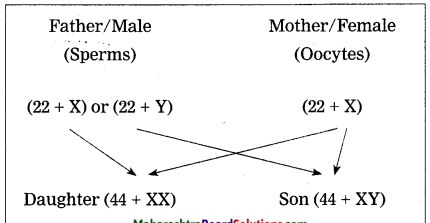
Sex determination in Human being
(1) The statement Gender of child is determined by the male partner of couple is true.
(2) It is clearly seen from the diagram that there are two types of sperms produced by males. One sperm has a X chromosome while the other has a Y chromosome, apart from autosomes. The mother on the other hand has all X bearing oocytes. Thus the sperm that fertilizes the oocyte decides the sex of the child.
(3) If X bearing sperm fertilizes the oocyte, daughter is born and when Y bearing sperm fertilizes the oocyte, son is born.
(4) Thus father or male partner is responsible for the determination of the sex.
Question 9.
Explain asexual reproduction in plants.
Answer:
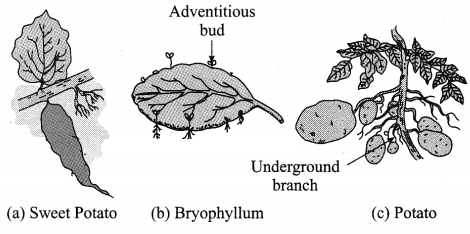
- Vegetative propagation is the method of asexual reproduction in plants.
- It takes place with the help of vegetative parts like root, stem, leaf and bud.
- Potato, suran (Amorphophallus) and other tubes propagate with the help of ‘eyes’ which are buds. These eyes are present on the stem tubers.
- In case of plants like sugarcane and grasses, buds present on nodes perform vegetative propagation.
- Plants like Bryophyllum performs vegetative propagation with the help of buds present on leaf margin.

Question 10.
Modern techniques like surrogate mother, sperm bank and IVF technique will help the human beings. Justify this statement.
OR
Despite various diagnostic tests, a couple could not have a child. In this situation, which remedies will you suggest? (July 2019)
Answer:
(1) Some couples want a child but they are not able to bear one due to various problems either in mother or in father. In such cases modern techniques such as IVF, surrogacy and sperm bank are useful in conceiving a child.
(2) These methods are as follows:
(i) Surrogacy: In woman if there is problem regarding the implantation of embryo in uterus, then help of another women is taken. This women is called surrogate mother.
Oocyte from real mother is taken out and fertilized with sperms collected from her husband. These gametes are fertilized outside in a test-tube and then the fertilized zygote is implanted in the surrogate mother.
(ii) In Vitro Fertilization (IVF) is done when there are problems like less sperm count or obstacles in oviduct. In IVF, fertilization is done in the test-tube. The embryo formed is implanted in uterus of woman for further growth.
(iii) Sperm bank: If man has problems with the sperm production, then the sperms are collected from the sperm bank. Sperm bank is the place where the donor’s donate the sperms and such sperms are kept stored. The donor’s identity is kept secret and he should also be physically and medically fit person.
Question 11.
Explain sexual reproduction in plants.
(OR)
Explain double fertilization in plants.
Answer:
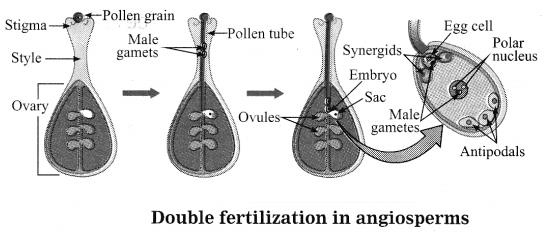
- Plants reproduce sexually with the help of flowers.
- Androecium and gynoecium are male and female parts of the flowers respectively.
- In the carpel, the ovule undergoes meiosis and forms embryo sac.
- A haploid egg cell and two haploid polar nuclei are present in each embryo sac.
- The pollen grains from the anther reach the stigma of flower by the process of pollination. They germinate here on the stigma.
- As a result of germination, long pollen tube and two male gametes are formed.
- The pollen tube travels through the style of flower and the male gametes present in the pollen tube are transferred till the embryo sac in ovary. Upon reaching there, tip of the pollen tube bursts releasing two male gametes in embryo sac.
- One male gamete unites with the egg cell and forms zygote. While other male gamete unites with two polar nuclei forming the endosperm.
- Because there are two nuclei participating in this process, therefore it is called double fertilization.
- After fertilization ovule develops into seed and ovary forms a fruit. When the seed again gets favourable conditions, it can produce a new plant.
Activities: (Do it your self)
Question 1.
Collect the official data about present and a decade old population of various Asian countries and plot a graph of that data. With the help of it, draw your conclusions about demographic changes.
Question 2.
With the help of your teacher, compose and present a road show to increase the awareness about prenatal gender detection and gender bias.

Can you recall? (Text Book Page No. 22)
Question 1.
Which are the important life processes in living organisms?
Answer:
The important life processes in living organisms are respiration, circulation, nutrition, excretion, sensation and response through nervous system.
Question 2.
Which life processes are essential for production of energy required by body?
Answer:
The oxidation of nutrients that are absorbed in body is done because of oxygen supplied to cells by respiratory and circulatory system. This helps in liberation of energy. Thus respiration, circulation and nutrition are the life processes that are essential for production of energy required by body.
Question 3.
Which are main types of cell division? What are the differences?
Answer:
The main types of cell division are mitosis and meiosis. In mitosis, the chromosome number remains the same. 2 daughter cells are obtained from one cell. In meiosis, the chromosome number is reduced to half. From one cell, four daughter cells are obtained.
Question 4.
What is the role of chromosomes in cell division?
Answer:
Due to chromosomes, the DNA from parental cells enter into daughter cells. The hereditary, characters are transmitted to next generation by cell division.
Can you recall? (Text Book Page No. 22)
Question 1.
What do we mean by maintenance of species?
Answer:
Maintenance of species means a species undertakes successful reproduction and produces individuals of its own kind. This keeps the species existing on the earth.
Question 2.
Whether the new organism is genetically exactly similar to earlier one that has produced it?
Answer:
No. The new organism produced from the old one is not genetically exactly similar to the parents. In meiotic cell division there is crossing over in the homologous chromosomes. This produces genetic recombination. Thus the new organism is different from the earlier one. However, if the reproduction is of asexual type, then the young one is exactly similar to the parents.

Question 3.
Who determines whether the two organisms of a species will be exactly similar or not?
Answer:
The type of reproduction, whether it is asexual or sexual, the type of crossing over, the extent of genetic recombination, etc. determine the similarity among the parent organisms and their, offspring. Based on this genetic recombination the two organisms of a species do not show exact similarity. However, in case of monozygotic twins there is exact similarity. In asexual reproduction to there is similarity.
Question 4.
What is the relationship between the cell division and formation of new organism of same species by earlier existing organism?
Answer:
In the process of reproduction, there is division of chromosomes. Due to cell division, the gametes are formed. The union of gametes produce new offspring. In sexual reproduction, all these processes take place due to cell division. In asexual reproduction too there is cell division. Growth of new organism also occurs due to cell division.
Let’s Think: (Text Book Page No. 26)
Question 1.
What would have been happened if the male and female gametes had been diploid?
Answer:
Diploid (2n) gametes if united, they will form 4n, i.e. tetraploid variety. Such zygote will show severe abnormality. The chromosome number will not be maintained.
Question 2.
What would have been happened if any of the cells in nature had not been divided by meiosis?
Answer:
If meiosis does not happen the gametes produced will be diploid. This will create abnormality.
Can you recall? (Text Book Page No. 28)
Question 1.
Which different hormones control the functions of human reproductive system through chemical coordination?
Answer:
Pituitary gland secretes FSH and LH. LH is known as ICSH in males, as its function in the male body is different. From the gonads of male and female, hormones are secreted which are essential for male and female reproductive functions respectively. These hormones are testosterone secreted from testis in males and estrogen and progesterone secreted from the ovaries in females. Testosterone is essential for masculinity as well as for sperm production while female hormones are essential for changes in the female body leading to motherhood.
Question 2.
Which hormones are responsible for changes in human body occurring during onset of sexual maturity?
Answer:
Testosterone in male body and estrogen in female body are responsible for maturity onset changes in human body.

Question 3.
Why has the Government of India enacted the law to fix the minimum age of marriage as 18 in girls and 21 in boys?
Answer:
The full growth of female body is not completed till the age of 18. Till 18 years of age the physical and emotional maturity is not attained. Therefore, she is not suitable for marriage, sexual relationship and pregnancy. Similarly, boy attains complete growth only the age of 21. Therefore, to keep individuals and their progeny safe and healthy the Government of India enacted the law to fix the minimum age of marriage as 18 in girls and 21 in boys.
Can you recall? (Text Book Page No. 31)
Question 1.
Which hormone is released from pituitary of mother once the foetal development is completed?
Answer:
The hormone oxytocin is released from the posterior pituitary of mother once the foetal development is completed.
Question 2.
Under the effect of that hormone, which organ of the female reproductive system starts to contract and thereby birth process (parturition) is facilitated?
Answer:
Due to oxytocin, uterus contracts involuntarily and the baby is expelled out. Thus initiation of birth process is possible due to contractions of uterus.
Use your brain power. (Text Book Page No. 24)
Question 1.
Does the parent cell exist after asexual reproduction-fission?
Answer:
In fission, the parent cell divides into two. This nucleus and cytoplasm, both are divided. Thus, parent cell does not exist any longer, it is converted into new cells.
Choose the correct alternative and write that alphabet against the sub-question number:
Question 1.
Pranav and Pritee are twins in your class. They belong to ……….. twins type.
(a) monozygotic
(b) dizyotic
(c) siamese
(d) none of the above
Answer:
(b) dizyotic
Question 2.
Longitudinal binary fission is seen in …………..
(a) Paramoecium
(b) Euglena
(c) Amoeba
(d) Spirogyra
Answer:
(b) Euglena
Question 3.
Yeast cell performs asexual reproduction by ……………..
(a) fragmentation
(b) budding
(c) binary fission
(d) regeneration
Answer:
(b) budding
Question 4.
Carrot and raddish undergoes …………. with the help of their roots.
(a) vegetative propagation
(b) fragmentation
(c) budding
(d) regeneration
Answer:
(a) vegetative propagation
Question 5.
Androecium and gynoecium are ……….. whorl of the flower.
(a) accessory
(b) essential
(c) external
(d) internal
Answer:
(b) essential
Question 6.
Flowers without stalk are called ……….. flowers.
(a) stalkless
(b) sessile
(c) incomplete
(d) complete
Answer:
(b) sessile
Question 7.
………….. on the inner surface of fallopian ducts (oviducts) push the egg towards uterus.
(a) Cilia
(b) Tentacles
(c) Flagella
(d) Fibres
Answer:
(a) Cilia
Question 8.
Pregnant mother supplies nourishment to her foetus through …………..
(a) breasts
(b) uterus
(c) placenta
(d) ovaries
Answer:
(c) placenta

Question 9.
The length of a sperm is about …………. micrometers.
(a) 400
(b) 5
(c) 60
(d) 600 (July ’19)
Answer:
(c) 60
Question 10.
Vegetative propagation is performed with the help of ……….. in sweet potato.
(a) root
(b) stem
(c) leaf
(d) flower
Answer:
(a) root
Question 11.
Which of the following is not a unisexual flower?
(a) Coconut
(b) Papaya
(c) Gulmohar
(d) Maize
Answer:
(c) Gulmohar
Write whether the following statements are true or false, with the suitable reason:
Question 1.
Absence of genetic recombination is an advantage whereas fast process is drawback of asexual reproductive method.
Answer:
False. (Absence of genetic recombination is a drawback whereas fast process is advantage of asexual reproductive method.)
Question 2.
Prokaryotes show fission which occurs either by mitosis or amitosis.
Answer:
True. (Prokaryotes show fission by both the methods, i.e. mitosis and amitosis.)
Question 3.
During favourable conditions multiple fission is performed by amoeba.
Answer:
False. (During unfavourable conditions multiple fission is performed by amoeba.)
Question 4.
Any encysted Amoeba or any other protist is called ‘Cyst’.
Answer:
True. (Cyst is the tough capsule like structure which keeps the protists dormant inside it. This helps the organisms to tide over unfavourable conditions.)
Question 5.
If the body of Sycon breaks up accidentally into only large and few fragments, then only each fragment develops into new Sycon.
Answer:
False. (If the body of Sycon breaks up accidentally into many fragments, each fragment develops into new Sycon. Because the capacity to regenerate is very strong in poriferan Sycon, even a small piece of parent Sycon can give rise to entire new individual.)
Question 6.
Pollen tube reaches the zygote via style.
Answer:
False. (Pollen tube reaches the embryo sac via style. Later, double fertilization takes place and the zygote and endosperm are formed.)
Question 7.
There is glucose sugar in the semen.
Answer:
False. (There is fructose sugar in the semen. Glucose is not present in semen.)
Question 8.
Out of 2 – 4 million ova, approximately only 400 oocytes are released up to the age of menopause.
Answer:
True. (During the reproductive span of the woman, from menarche to menopause only one oocyte per one month is released in the span of 30 to 35 years.)
Question 9.
If the oocyte is fertilized, secretion of estrogen and progesterone stops completely.
Answer:
False. (If the oocyte is not fertilized, there is no need of corpus luteum which secretes progesterone. In absence of conception, the progesterone is not needed, thus corpus luteum degenerates and forms corpus albicans.)

Question 10.
During menstruation there is need of rest along with special personal hygiene.
Answer:
True. (During phase of menstruation there is pain and bleeding in woman. Her body is also susceptible for infections. There is weakness and hence she needs rest along with special personal hygiene.)
Find the odd one out:
Question 1.
Circulation, Excretion, Sensation, Reproduction.
Answer:
Reproduction. (All others are processes necessary for survival of the individual.)
Question 2.
Budding in hydra, Regeneration, Binary fission, Fragmentation
Answer:
Binary fission. (All others are processes of asexual reproduction in multicellular organisms.)
Question 3.
Carrot, Radish, Potato, Sweet potato.
Answer:
Potato. (All others are edible roots.)
Question 4.
Vas eferens, vas deferens, prostate gland, epididymis.
Answer:
Prostate gland. (All others are duct systems in male reproductive system.)
Question 5.
Prostate gland, Bartholin’s gland, Cowper’s gland, Epididymis.
Answer:
Bartholin’s glands. (All others are parts of male reproductive system.)
Question 6.
Stigma, style, pollen, ovary.
Answer:
Pollen. (All others are parts of gynoecium.)
Identify the correlation between the first two words and suggest the suitable words in the fourth place:
Question 1.
Amoeba : Fission : : Hydra : ………….
Answer:
Amoeba : Fission : : Hydra : Budding
Question 2.
Transverse binary fission : Paramoecium : : Longitudinal binary fission : ………… (July ‘19)
Answer:
Transverse binary fission : Paramoecium : : Longitudinal binary fission : Euglena
Question 3.
Calyx : Sepals : : Corolla : ………….
Answer:
Calyx : Sepals : : Corolla : Petals
Question 4.
Accessory whorls : Calyx and corolla : : Essential whorls : ………..
Answer:
Accessory whorls : Calyx and corolla : : Essential whorls : Androecium and gynoeciuin
Question 5.
Bisexual flower : Hibiscus : : Unisexual flower : ………….
Answer:
Bisexual flower : Hibiscus : : Unisexual flower : Papaya
Question 6.
FSH : Development of qocyte : : LH : ………….
Answer:
FSH : Development of qocyte : : LH : Ovulation

Define the following/Give meanings of the following:
Question 1.
Budding in yeast.
Answer:
Budding in yeast: Budding is the asexual reproductive process in which a! small bulge or bud appears on the surface of parent cell as seen in unicellular yeast.
Question 2.
Budding in hydra.
Answer:
Budding in hydra: Budding in hydra is asexual reproductive process in which an outgrowth is formed by repeated divisions of regenerative cells of body wall called bud.
Question 3.
Regeneration.
Answer:
Regeneration: Regeneration is the asexual reproduction in Planaria in which the body is broken up into two parts and resulting each part regenerates remaining part of the body.
Question 4.
Fragmentation.
Answer:
Fragmentation: Fragmentation is the asexual type of reproduction in which the body of parent organism breaks up into many fragments. Each fragment can start living independently.
Question 5.
Vegetative propagation.
Answer:
Vegetative propagation: Vegetative propagation is a type of asexual reproduction in plants that takes place with the help of vegetative parts like root, stem, leaf and bud.
Question 6.
Fertilization.
Answer:
Fertilization: The process by which two haploid gametes unite to form a diploid zygote is called fertilization.
Question 7.
Pedicel.
Answer:
Pedicel: The stalk of the flower which is for the support is called pedicel.
Question 8.
Pollination.
Answer:
Pollination: Transfer of pollen grains from anther to the stigma is called pollination.
Question 9.
Self-Pollination.
Answer:
Self-Pollination: Pollination involving only one flower or two flowers borne on same plant is called self-pollination.
Question 10.
Cross-Pollination.
Answer:
Cross-Pollination: Pollination involving two flowers borne on two plants of same species is cross-pollination.
Question 11.
Endosperm.
Answer:
Endosperm: Endosperm is the nourishing substance formed by the union of second male gamete with two polar nuclei at the time of fertilization in plants.
Question 12.
Embryo sac.
Answer:
Embryo sac: There are many ovules in the ovary, the structure formed in each of the ovule by meiosis is called embryo sac.
Question 13.
Menopause.
Answer:
Menopause: Stoppage of functioning of female reproductive system due to lack of synthesis of hormones due to advancing age is called menopause.
Question 14.
Placenta.
Answer:
Placenta: An organ developed in the uterus of the pregnant mother, through which the embryo is given nourishment is called placenta.

Question 15.
Menstrual cycle.
Answer:
Menstrual cycle: The repetitive changes at the interval of every 28-30 days in female reproductive system that take place after puberty, form menstrual cycle.
Question 16.
Corpus luteum.
Answer:
Corpus luteum: Corpus luteum is the secondary structure that is formed from empty ovarian follicle after ovulation. This corpus luteum produces progesterone and thereby maintains pregnancy.
Question 17.
Corpus albicans.
Answer:
Corpus albicans: Corpus albicans is the degenerate body which is formed from corpus luteum, if the ovum is not fertilized.
Question 18.
Ovulation.
Answer:
Ovulation: Bursting of mature ovarian follicle under the influence of hormones to release the oocyte is called ovulation.
Question 19.
IVF.
Answer:
IVF: In Vitro Fertilization is the technique in which fertilization is brought about outside the female body but in the test-tube and the embryo is implanted in uterus of woman.
Question 20.
Sperm bank.
Answer:
Sperm bank: Sperm bank is the place where semen donated by the desired men is collected after their thorough physical and medical check-up and stored at sub-zero temperatures in sterile conditions.
Name the following/Give the names:
Question 1.
Different glands associated with male reproductive system.
Answer:
Seminal vesicles, Prostate gland, Cowper’s or bulbourethral glands.
Question 2.
Agents of pollination.
Answer:
Biotic: Insects, birds, few animals.
Abiotic: Water and wind.
Question 3.
Components of semen.
Answer:
Secretion of prostate gland seminal vesicles and Cowper’s glands along with sperms.
Question 4.
Two accessory whorls in flower.
Answer:
Calyx and corolla.

Question 5.
Two essential whorls in flower.
Answer:
Androecium and gynoecium.
Question 6.
The modern techniques in reproduction.
Answer:
In Vitro Fertilization, Surrogate mother, Sperm bank.
Question 7.
Symptoms of gonorrhea.
Answer:
Painful and burning sensation during urination, oozing of pus through penis and vagina, inflammation of urinary tract, anus, throat, eyes, etc.
Question 8.
Symptoms of syphilis.
Answer:
Occurrence of chancre (patches) on various parts of body including genitals, rash, fever, inflammation of joints, alopecia, etc.
Write the functions of the following organs:
Question 1.
Sporangium.
Answer:
Storing the spores and releasing them by bursting.
Question 2.
Calyx.
Answer:
Protection of inner whorls of the flower.
Question 3.
Corolla.
Answer:
Attracting insects for pollination. Protecting inner whorls.
Question 4.
Androecium.
Answer:
Production of pollen grains, the male gametes of flower.
Question 5.
Gynoecium.
Answer:
Production of female gametes of flower. Participating in production of fruits.
Question 6.
Endosperm.
Answer:
Nourishment of the growing embryo.
Question 7.
Testis.
Answer:
Production of sperms and male hormone-testosterone.
Question 8.
Scrotum.
Answer:
Protection and temperature control of testis.
Question 9.
Seminal vesicles.
Answer:
Secretion of seminal fluid which forms major portion of semen. Nourishment of sperms.
Question 10.
Penis.
Answer:
Transferring of sperms to vagina at the time of intercourse. Release of urine at the time of urination.
Question 11.
Ovary.
Answer:
Production of oocytes and female hormones – estrogen and progesterone.
Question 12.
Uterus.
Answer:
Growth and development of foetus during pregnancy. Helping in parturition (childbirth) by contractions.
Question 13.
Fallopian tubes/ducts.
Answer:
Transporting the released oocyte after ovulation to the uterus. Providing space for fertilization of oocyte by sperm. Conception is possible only when sperm and oocyte meet in the fallopian tube.
Question 14.
Vagina.
Answer:
Passage for copulation/intercourse. Birth canal. Passage for menstrual flow.
Question 15.
Placenta.
Answer:
Supplying nourishment to the growing foetus.
Distinguish between:
Question 1.
Binary fission and Multiple fission.
Answer:
Binary fission:
- Two new individuals are formed from one old individual at one time.
- The division of nucleus and cytoplasm takes place initially.
- The axis of division can be transverse, longitudinal or any one axis as it is in simple binary fission.
- Formation of protective cyst does not take place.
- Binary fission can be done during favourable period.
Multiple fission:
- Many new individuals are formed from one old individual at one time.
- Only nucleus divides initially followed by division of cytoplasm.
- There is no exact axis for the fission.
- Protective covering is formed around dividing amoebulae which is called cyst.
- Multiple fission takes place only at the time of unfavourable period.
Question 2.
Human male and Human female reproduction system.
Answer:
Human male reproductive system:
- Testis are essential organs which are located outside the abdomen in the scrotal sacs.
- There is common urethra through which urine and semen, are passed out.
- Reproductive system of male continues to work even in old age.
- Sperms or male gametes are produced by meiosis in the testis.
- Sperms are produced in millions at one time.
- Three accessory glands are associated with the male reproductive system.
- Testis secrete testosterone which is essential male hormone.
Human female reproductive system:
- Ovaries are essential organs which are located along with all other organs inside the lower abdomen.
- Urethra and vagina are two separate openings that open to outside.
- Reproductive system works only till menopause.
- Oocytes or ova are produced by meiosis in the ovaries.
- Only single oocyte is produced per month.
- Only one gland is associated with female reproductive system.
- Ovaries produce estrogen and progesterone which are essential female hormones.

Question 3.
Monozygotic twins and Dizygotic twins.
Answer:
Monozygotic twins:
- Two children developing from only one zygote are called monozygotic twins.
- Monozygotic twins develop from same oocyte.
- Gender of both the twins is same.
- The monozygotic twins are genetically exactly alike.
Dizygotic twins:
- Two children developing from two different zygotes are called dizygotic twins.
- Dizygotic twins develop from two different oocytes.
- Gender of both the twins can be same or can be different.
- The dizygotic twins are genetically not exactly alike.
Give scientific reasons:
Question 1.
Individual developed by sexual reproduction always carry recombined genes of both the parents.
Answer:
- In sexual reproduction, the haploid male and female gametes are united to form diploid zygote.
- The zygote thus carries chromosomes of both parents which are transferred via male and female gametes.
- While producing gametes, there is meiosis in which genetic recombination takes place.
- Therefore, the individual developed by sexual reproduction always carry recombined genes of both the parents.
Question 2.
Flower is the structural unit of sexual reproduction in plant.
Answer:
- Flower produces male and female gametes.
- For this purpose there are essential whorls of androecium and gynoecium.
- The double fertilization also takes place in flower.
- Therefore, flower is called the structural unit of sexual reproduction in plants.
Question 3.
Fertilization in plants is called double fertilization.
Answer:
- After pollination the pollen grains drop on the sticky stigma of the flower.
- They germinate here producing two male gametes and a long pollen tube.
- The male gametes travel through the pollen tube till they reach the embryo sac.
- Here the male gametes are released by bursting the pollen tube. One male gamete unites with the egg cell to form zygote while the second male gamete unites with two polar nuclei forming endosperm.
- In this way because two nuclei participate in the fertilization process, therefore it is called double fertilization.
Question 4.
By the age of 45 – 50 women gets menopause.
Answer:
- By the age of 45-50, the secretion of hormones which control the functioning of the reproductive system is reduced gradually and then it stops.
- This causes end of menstrual cycle. This results into menopause.
Question 5.
Older mothers have greater chance of conceiving abnormal children.
Answer:
- In older women the menopausal age approaches.
- The oocytes, released from ovaries during this phase are not normal.
- Their meiotic cell division is abnormal and thus oocyte becomes abnormal too.
- If such abnormal oocytes are fertilized, the baby is born with many genetic problems, e.g. Down’s syndrome or Turner’s syndrome.
Question 6.
Indians should follow family planning for controlling the population.
Answer:
- There is severe population explosion in India. It has almost reached to 121 crores.
- This results into unemployment, decreasing per capita income and increasing loan, stress on natural resources, etc.
- Only by controlling population, the quality of life can be restored.
- Therefore, Indians should follow family planning for controlling the population.
Answer the following questions in short:
Question 1.
How does reproduction take place in fungus Mucor?
Answer:
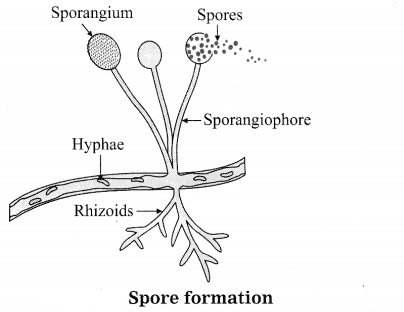
- Mucor reproduces asexually by spore formation.
- It has filamentous body that possess sporangia.
- When the spores are formed, the sporangia burst. The spores are released which settle down at suitable Places.
- They germinate in moist and warm place forming a new fungal colony.
Question 2.
What is the type of asexual reproduction shown in the diagram below? (Board’s Model Activity Sheet)
Answer:
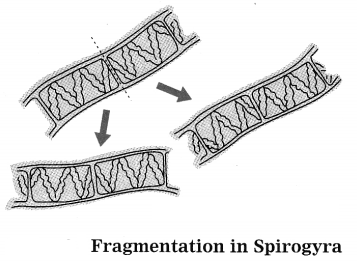
Type of asexual reproduction shown in the diagram above is fragmentation in Spirogyra.

Question 3.
Describe the structure of a flower.
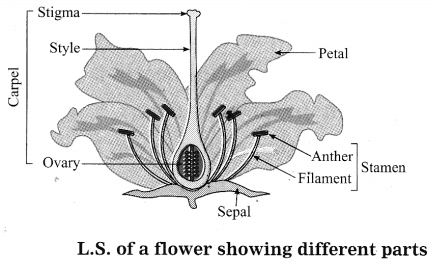
Answer:
(1) The structural unit of sexual reproduction in plants is flower. There are total four floral whorls. Of these, two are accessory floral whorls while two are essential floral whorls.
(2) Calyx and corolla are accessory whorls. They are protective in nature.
(3) Members of calyx are known as sepals. They are usually green in colour. They protect the inner whorls.
(4) The members of corolla are called petals. They can be of different colours.
(5) Androecium and gynoecium are essential whorls as they participate in sexual reproduction.
(6) The male whorl androecium is made up of stamens. Each stamen has a filament with anther located at the upper end. In the anther there are four locules. Inside the locules the meiosis takes place forming pollen grains. During suitable time, the pollen grains are released from anther lobes.
(7) Gynoecium is made up of carpels, either in separate form or are united. Each carpel is formed of ovary at the basal end hollow ‘style’ and the stigma at the tip of style. There are one or many ovules inside the ovary.
(8) In bisexual flowers both androecium and gynoecium are located in the same flower, e.g. Hibiscus.
(9) In unisexual flowers, androecium is present in male flowers and gynoecium is present in the female flowers, e.g. Papaya.
Question 4.
Describe the human male reproductive system.
Answer:
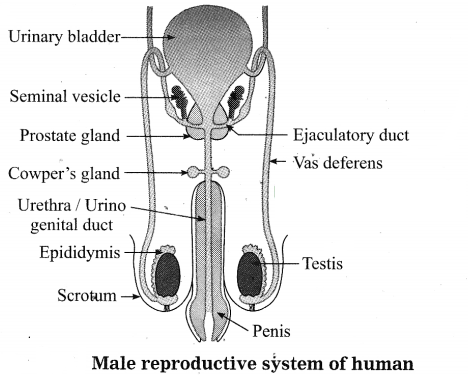
In human male reproductive system, the reproductive organs are as follows:
- Testes, different types of duct systems and glands.
- Testes are in pair. Each testis lies in the scrotum which lies outside to abdominal cavity.
- Testes -consist of numerous seminiferous tubules. The germinal epithelium of seminiferous tubules form sperms by undergoing meiosis.
- These sperm cells are immature.
- They are pushed gradually through various duct systems till the penis.
-
This path is as follows:
Rete testis → vas efferentia → epididymis → vasa deferentia → Ejaculatory duct → urethra - As the sperms are travelling, they gradually become mature. They are made capable to perform process of fertilization.
- Seminal vesicles (in pairs), Single prostate gland and a pair of Cowper’s glands secrete their secretions. These secretions and the sperms together form semen.
- This semen is deposited in the vagina with help of penis.
Question 5.
Describe the human female reproductive system.
Answer:
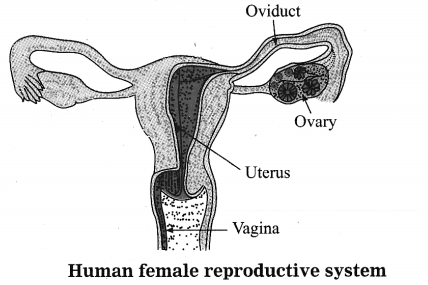
- All the organs of the human female reproductive system are located inside the lower abdomen.
- There are pair of ovaries, pair of fallopian ducts and a single median uterus.
- The uterus opens out by vagina. In vaginal walls there are Bartholin’s glands.
- The urethra in female body is separate and not a common passage as in male body.
- The free end of fallopian duct is funnel-like having an opening in the centre. The oocyte released from the ovary due to ovulation is picked up by this funnel.
- The other end of fallopian duct opens into uterus. There are cilia on inner surface of oviduct. With the help of the cilia the oocyte is pushed to the uterus through the fallopian duct.
- The fertilization of oocyte can take place only in the middle’part of the fallopian duct.
- The lower end of uterus opens into vagina. The contractions of uterus help in the process of parturition.
- Vagina is the birth canal as well as copulatory passage. It is also a passage for menstrual flow.
Question 6.
What problems cause infertility in couple?
Answer:
- In woman if there are problems like irregularity in menstrual cycle, difficulties in oocyte production or implantation in uterus, obstacles in the oviduct, etc.
- In man if there are no sperms in the semen, slow movement of sperms, or anomalies in the sperms then he becomes sterile.
- But now with the help of advanced medical techniques these problems can be overcome and a childless couple can be parents.
Question 7.
Answer the following questions: (July 2019)
(a) In our country, there seems to be lack of awareness regarding reproductive health. Why?
(b) Write the symptoms of disease gonorrhea.
(c) What precautions will you take to maintain reproductive health?
Answer:
(a) There is lack of awareness about reproductive health among majority of people of our country. This is due to social customs, traditions, illiteracy, social taboo and shyness.
(b) Symptoms of gonorrhea are as follows:
- Painful burning during urination.
- Oozing of pus through penis or vagina.
- Inflammation of urinary tract, anus, throat, eyes, etc.
(c) Precautions to maintain reproductive health are cleanliness and personal hygiene. Guarding against any sexual infections.
Question 8.
If a piece of bread is kept in a container in moist place for 2-3 days, (1) What will you see? (2) Write scientific name and a character of the organism you may observe.
Answer:
(1) If a piece of bread is kept in moist container we can see growth of fungus on it.
(2) Fungi belonging to species Mucor is seen. It has filamentous body and sporangia. Sporangia burst open to spread spores. It has saprophytic mode of nutrition as it devoid of chlorophyll.
Write short notes on:
Question 1.
Multiple fission.
Answer:
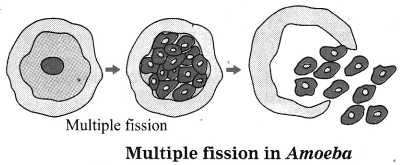
During unfavourable conditions when there is lack of food. multiple fission is shown by amoeba. Amoeba forms protective covering and becomes encysted. Inside the cyst, amoeba undergoes repeated nuclear division. This is followed by cytoplasmic divisions. Many amoebulae are formed which remain dormant inside the cyst. When favourable conditions reappear, they come out by breaking the cyst.
Question 2.
Regeneration.
Answer:
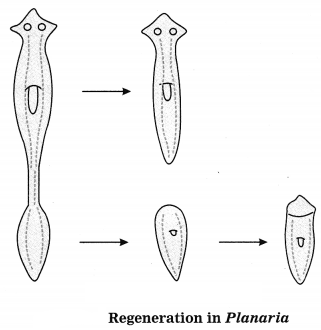
In developed animals like wall lizard the process of regeneration is used to restore the lost parts like tail or limbs. As the reproductive system is one of the fullfledged system in the body, the process of regeneration cannot be called type of reproduction.
But some primitive organisms such as Plarfaria use this method for procreation. Planaria breaks up its body into two parts. Each part has the ability to develop the lost part by process of regeneration. This forms two new Planaria.
Question 3.
Seed germination.
Answer:
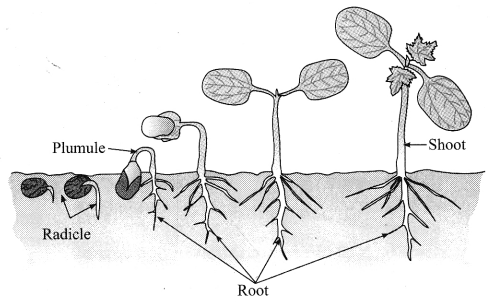
Seed germination is the process in which the seed develops into a new plantlet. In the plants, after fertilization the ovule develops into seed and ovary turns into fruit. Seeds fallen on the ground due to bursting of the fruits start germinating. Only under favourable conditions in the soil, this germination takes place. The zygote present inside the seed uses food stored in endosperm of seed and hence develops further to produce a new plantlet.

Question 4.
Budding in hydra.
Answer:
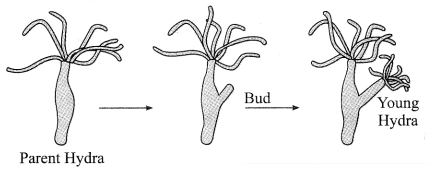
In multicellular organisms asexual reproduction by budding is shown by hydra. In fully grown Hydra, at specific part of its body there is development of bud.
This development is only during favourable period. The bud is an outgrowth developed due to repeated divisions of regenerative cells of body wall. It grows up gradually to form a small hydra. Parent hydra’s dermal layers and digestive cavity are in continuity with those of the budding hydra. It receives all the nutrition from parent hydra.When the budding hydra grows sufficiently, it detaches from parent hydra. Then it leads an independent life.
Question 5.
Fragmantation.
Answer:
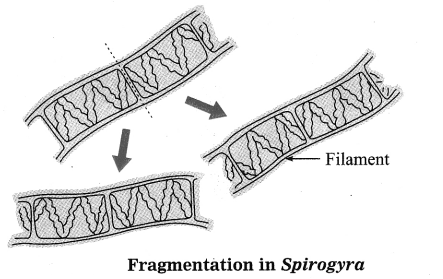
Fragmentation is one of the type of asexual reproduction in multicellular organisms. During fragmentation, the body of parent organism breaks up into many fragments. All the resulting fragments start to develop as an independent new organism. In alga Spirogyra, and sponge like Sycon asexual reproduction takes place by fragmentation. Spirogyra grow up very fast and break up into many small fragments when there are favourable conditions. Each newly formed fragment lives independently as a new Spirogyra. Similarly the body of Sycon if accidentally broken into many fragments, develops into new Sycon from each old fragment.
Question 6.
Monozygotic twins.
Answer:
The twins developed from a single embryo are called monozygotic twins. If within 8 days of zygote formation i.e. in early embryonic development cells of that embryo divide into two groups. Each one develop as two separate embryos forming two monozygotic twins. Monozygotic twins are genetically exactly similar to each other. The gender of the twins is also same.
The Siamese twins develop from monozygotic twins, if the embryonic cells are divided into two groups 8 days after the zygote formation. These are conjoined twins where some parts of body are joined to each other. Also some organs are common in Siamese twins.
Read the paragraph and answer the questions given below:
Reproduction is the process by which the living species continues its existence. Lower organisms carry out asexual reproduction while higher plants and animals always show sexual reproduction. Plants reproduce asexually by methods such as fragmentation, vegetative propagation, budding, spore formation. For sexual reproduction they form gametes. In animal kingdom, budding, fission of different types and parthenogenesis are some of the methods that do not require both the sexes. Though regeneration also forms new individual, it is not considered to be a reproductive process because, basically it is a repair process. The ability to regenerate is lost in higher phyla. In human beings | it is restricted only to wound healing. Sexual reproduction is also undergoing lots of experimentation such as cloning which may make females capable of producing their own baby without intervention of any male.
Questions and Answers:
Question 1.
How do living species continue their existence?
Answer:
Through the process of reproduction, living species continue their existence.
Question 2.
Which are asexual methods of reproduction in kingdom Animalia?
Answer:
Fission, budding and parthenogenesis are the asexual methods of reproduction in Kingdom Animalia.
Question 3.
Why is regeneration not true method of reproduction?
Answer:
Regeneration is the repair process than a reproductive process. It is not done with the intention of producing offspring, but is for healing or repairing the lost part.
Question 4.
What are methods of reproduction in plants?
Answer:
Plants reproduce by asexual as well as sexual methods. Asexual reproduction is by fragmentation, vegetative propagation, budding, spore formation, while by formation of gametes, sexual reproduction is done.
Question 5.
What is the modern method of reproduction aimed at in higher organisms?
Answer:
Cloning is the modern method of reproduction by which production of young one can be aimed at.
Diagram-based Questions:
Question 1.
Observe the figure 3.18 and answer the questions below: (Board’s Model Activity Sheet)
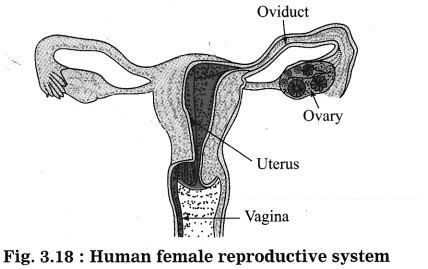
(a) What does the figure 3.18 indicate?
Answer:
The figure indicates the menstrual cycle in human female.
(b) Which human organs are involved in this process?
Answer:
The ovary and uterus are primarily involved in this process. But the pituitary gland also controls this cycle.
(c) Which hormones take part in this process?
Answer:
Following hormones regulate this menstrual cycle.
Pituitary hormones: Follicle Stimulating Hormone (FSH) and Luteinizing Hormone (LH).
Ovarian hormones: Estrogen and progesterone.
(d) What is the periodicity for these changes?
Answer:
The menstrual cycle shows repetitive changes every 28 to 30 days.
(e) The body of woman undergoing this process is impure, she should remain away from other people. What is your opinion about this statement? Give justification for your opinion.
Answer:
A menstruating woman is not at all with impure body. It is a natural process in which the endometrium of the uterus is sloughed off and repaired.
She should get enough rest and nutrition during this period. It is painful period in which there is a possibility of infections. Therefore, she should take ! hygienic care and rest till the bleeding persists. But blind faith and superstition to keep her away from others should not be followed.

Question 2.
Observe the diagram (Fig. 3.19) of menstrual cycle and answer the following questions:
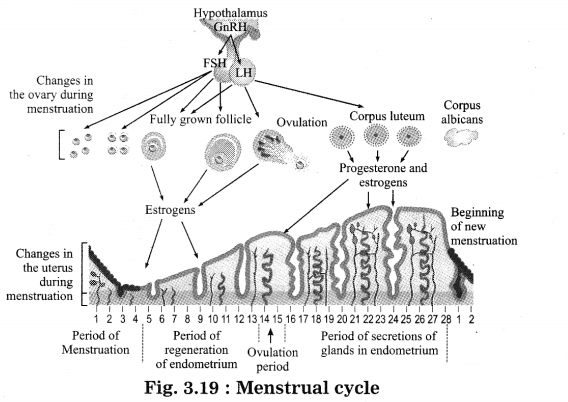
(1) What is the period of menstruation?
Answer:
1 to 5 days is the period of menstruation.
(2) On which day does ovulation occur during menstrual cycle?
Answer:
Ovulation occurs on 14th or 15th day.
(3) During which period is corpus luteum active during menstrual cycle? Which hormones are secreted by corpus luteum ?
Answer:
Corpus luteum is active till the 28th day of menstrual cycle. During this time if there is no union of sperm and ovum, then corpus luteum degenerates. Corpus luteum secretes estrogen and progesterone.
(4) In menstrual cycle which reproductive organs undergo changes?
Answer:
Ovary and uterus undergo changes during menstrual cycle.
(5) Which period is said to be period of regeneration of endometrium?
Answer:
In menstrual cycle, days 5 to 14 are period of regeneration of endometrium.
(6) Which period is said to be period of secretions of glands in endometrium?
Answer:
Period of secretions of glands in endometrium is 15 to 28 days.
Question 3.
Observe the following picture and describe the type of reproduction shown in.
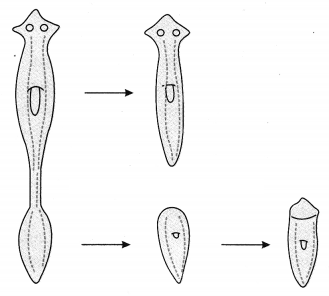
Answer:
In developed animals like wall lizard the process of regeneration is used to restore the lost parts like tail or limbs. As the reproductive system is one of the fullfledged system in the body. the process of regeneration cannot be called type of reproduction.
But some primitive organisms such as Planaria use this method for procreation. Planaria breaks up its body into two parts. Each part has the ability to develop the lost part by process of regeneration. This forms two new Planaria.
Question 4.
Answer the following questions: (March 2019)
(a) “Gender of child is determined by the male partner of couple.” Draw a diagram explaining the above statement.
Answer:
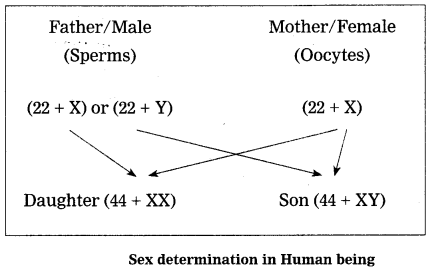
(b) Prepare a slogan for campaign against female foeticide.
Answer:
- Save the girl child.
- Daughters give lot of joy, it is not only the boy.
(c) In the following figure, explain how new fungal colonies of mucor are formed:
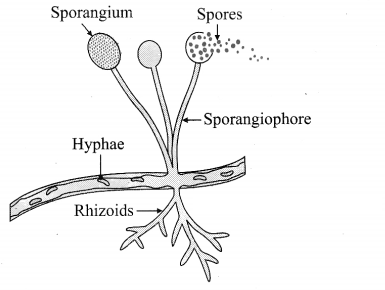
Answer:
Mucor is a fungus having filamentous body. The filaments bear sporangia. Mature sporangia burst and release spores. Spores germinate to form new hyphae upon getting favourable moist and warm place.
(d) Identify and state the type of reproduction represented in the above figure.
Ans. The spore formation is asexual type of reproduction seen in Mucor.
Question 5.
Write the type of asexual reproduction shown in the figure.

Answer:
The figure shows budding in yeast. Budding is the type of asexual reproduction.
Experiments:
(Try this: Text Book Pages 23 and 24)
(1) Observation of Paramoecia.
(2) Observation of yeast.
(3) Study of Hibiscus.
[For detailed information on practicals, refer to Vikas Science and Technology Experiment Book: Standard X]

Projects:
Project 1.
Use of ICT. (Textbook page no. 27)
Make an video album of pollination and show it in the class.
Project 2.
Internet is my friend. (Textbook page no. 33)
You may have read that sometimes a woman may deliver more than two offspring at a time. Collect more information from internet about reasons for such incidences.
Project 3.
Get information. (Textbook page no. 34)
Visit a public health centre nearby your place and collect the information through an interview of health officer about meaning and various methods of family planning.
